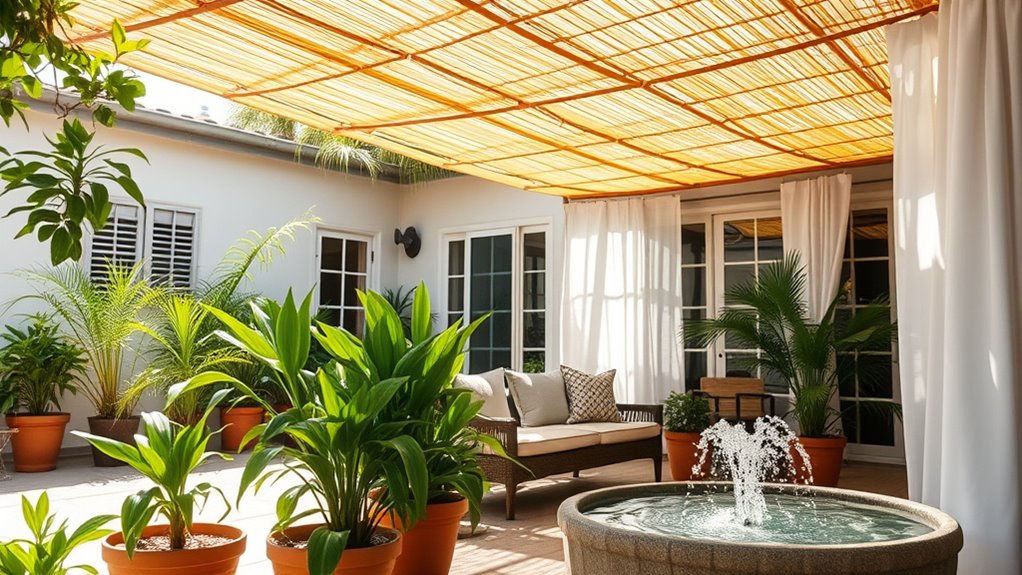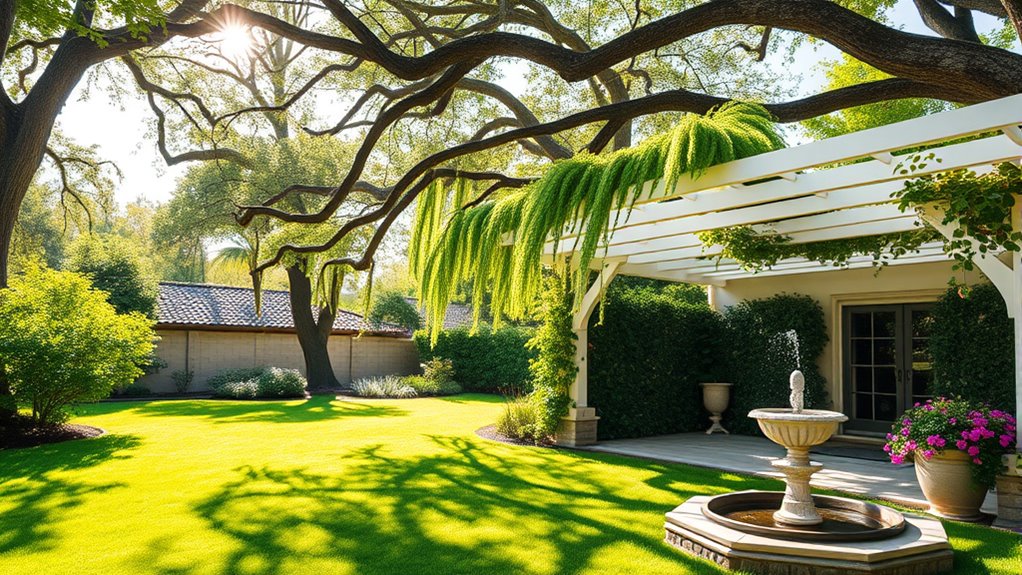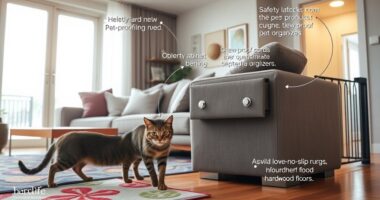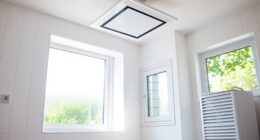To keep your home cool in summer without blasting the AC, use natural ventilation by opening windows early mornings and evenings to let in cool, dry air. Incorporate shading devices like overhangs or awnings to block the harsh sun and reflect heat away from your home. Employ fans to circulate air efficiently and consider installing evaporative coolers or using light-colored, reflective roofing. These sustainable methods can create a comfortable space—discover more ways to beat the heat naturally.
Key Takeaways
- Use evaporative cooling by opening windows early mornings and evenings to let in cool, dry air.
- Install shading devices like overhangs or awnings to block direct sunlight and reduce indoor heat gain.
- Incorporate reflective roofing materials to bounce sunlight away and decrease heat absorption.
- Promote cross-ventilation by opening windows on opposite sides to enhance airflow and lower indoor temperatures.
- Employ fans to circulate air effectively, distributing cooler air throughout your home without air conditioning.

Are you tired of sweating through the summer months while trying to keep your home cool? You don’t have to rely solely on air conditioning to stay comfortable. Instead, consider using evaporative cooling techniques combined with passive design strategies. These methods work together to naturally lower indoor temperatures without skyrocketing your energy bills or creating a climate impact.
Evaporative cooling is one of the most effective natural cooling methods. It works by adding moisture to the air, which helps lower the temperature through the process of evaporation. You can implement this simply by opening windows when the outside air is dry and cool, especially during early mornings and evenings. Installing an evaporative cooler, or swamp cooler, can also be a smart option if you want a more controlled approach. These units draw in warm, dry air and pass it over water-saturated pads, cooling the air before it enters your living space. The key is to use evaporative cooling during times when the outdoor air is dry, as it’s most effective under those conditions.
Use evaporative cooling by opening windows during dry, cool mornings and evenings for natural temperature regulation.
Passive design plays an essential role in naturally maintaining comfortable indoor temperatures. It involves designing and positioning your home to maximize airflow and minimize heat gain. For example, orient your house so that windows face away from harsh afternoon sun, reducing unwanted heat. Incorporate shading devices like overhangs, awnings, or pergolas to block direct sunlight from hitting windows during the hottest parts of the day. Using light-colored or reflective roofing materials helps bounce sunlight away instead of absorbing it, keeping your home cooler. Proper insulation is also important; it prevents heat from seeping in during the day and keeps cool air inside longer. Ventilation strategies, such as cross-ventilation, allow cooler outdoor air to flow through your home, pushing out hot indoor air naturally. You can achieve this by opening windows on opposite sides of your home or installing vents that facilitate airflow.
Combine these passive design features with evaporative cooling by creating a home environment that encourages airflow and heat reduction. For instance, leave windows open at night to let in cool air, then close them during the day and rely on shading and insulation to keep the heat out. Using ceiling fans or oscillating fans can help circulate the cool air efficiently. By integrating evaporative cooling with mindful passive design, you reduce your need for mechanical cooling and create a more sustainable, energy-efficient home climate. This approach doesn’t just cut costs; it also makes your living space more comfortable and environmentally friendly during even the hottest summer days.
Frequently Asked Questions
Can Plants Help Lower Indoor Temperatures Effectively?
Plants can definitely help lower indoor temperatures through plant shading and transpiration cooling. By placing leafy plants near windows, you create natural shade that blocks heat. Additionally, transpiration cooling occurs as plants release moisture, helping to lower surrounding air temperature. You’ll notice a cooler, more comfortable home environment without needing to blast the AC. Incorporating plants is an eco-friendly, aesthetic way to naturally regulate indoor heat.
What Are the Best Reflective Window Treatments?
Imagine you’re a knight defending your castle from the summer sun. Reflective blinds are your armor, blocking heat and glare effectively. Window film offers a modern shield, reflecting sunlight before it warms your home. Both are excellent choices, with reflective blinds providing adjustable coverage and window film delivering a sleek, permanent solution. Use these reflective window treatments to keep your space cooler, reducing reliance on air conditioning and staying comfortable all season long.
How Does Indoor Humidity Affect Perceived Temperature?
Indoor humidity greatly affects your humidity comfort and thermal perception. When humidity levels are high, your body struggles to cool itself through sweat, making the temperature feel hotter than it actually is. Conversely, lower humidity helps your sweat evaporate more efficiently, enhancing your comfort and making the room seem cooler. Managing indoor humidity through ventilation or dehumidifiers can optimize your comfort and help you feel more at ease in warm weather.
Are There Energy-Efficient Ceiling Fans for Cooling?
Oh, surely you want to chase the sun with those energy-hungry beasts? Instead, opt for eco-friendly fans with high ceiling fan efficiency. They use less power and still circulate air effectively, making them perfect for cooling without skyrocketing bills. Look for models with energy star ratings and adjustable speeds. You’ll enjoy a cooler home, guilt-free, while saving the planet—one fan at a time.
What DIY Methods Can Improve Airflow Naturally?
To improve airflow naturally, you can implement simple ventilation strategies like opening windows on opposite sides of your home to create cross-breezes. Use fans strategically to direct airflow and enhance circulation. Additionally, DIY insulation can help keep your home cooler by reducing heat transfer. Planting trees or shading windows also supports natural cooling. These methods work together to make your space more comfortable without relying on air conditioning.
Conclusion
Remember, a stitch in time saves nine. By implementing these simple tips—closing blinds, using fans wisely, and sealing gaps—you can keep your home cool without relying on air conditioning. These small actions add up, making a big difference in comfort and energy savings. Stay proactive and mindful of your home’s heat sources. In the summer heat, every little effort counts, proving that sometimes, less is more.








